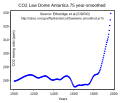Little Ice Age
Little Ice Age
The Little Ice Age (LIA) was a period of cooling that occurred after the Medieval Warm Period. Although it was not a true ice age, the term was introduced into scientific literature by François E. Matthes in 1939. It is conventionally defined as a period extending from the 14th to the 19th century, but some experts prefer an alternative timespan from about 1300 to about 1850. During this time, winters were harsh in many parts of the world, notably in the North Atlantic region. The phenomenon has been associated with volcanic eruptions, solar variability, and ocean circulation changes, among other factors.
Causes[edit]
Several causes have been proposed for the Little Ice Age, including solar activity, volcanic eruptions, and changes in ocean circulation. The Maunder Minimum, a period of low solar activity, coincided with the coldest part of the Little Ice Age, suggesting a significant impact of solar variability on climate. Additionally, several large volcanic eruptions during this period could have reduced the amount of solar radiation reaching the Earth's surface, further cooling the climate. Changes in the Atlantic Meridional Overturning Circulation (AMOC) may also have played a role in reducing the northward flow of warm water, contributing to cooler temperatures in the North Atlantic region.
Impact[edit]
The Little Ice Age had profound impacts on societies around the world. In Europe, it led to crop failures, famine, and disease, contributing to social unrest and economic hardship. The colder climate also forced changes in agricultural practices and helped spur innovations in farming. In the North Atlantic, sea ice expanded, affecting the fishing industry and the early European exploration of North America. The Vikings, for example, abandoned their Greenland settlements as the colder climate made farming increasingly difficult.
Historical Documentation[edit]
Historical records, including diaries, letters, and paintings, provide valuable insights into the conditions and societal impacts of the Little Ice Age. Notable examples include the frost fairs held on the frozen River Thames in London and the depiction of ice-skating on Dutch canals in paintings from the period. These records help to reconstruct the climate and its effects on human activity during the Little Ice Age.
Conclusion[edit]
The Little Ice Age was a significant climatic event that affected many parts of the world. Its causes are complex and multifaceted, involving a combination of natural factors. The period highlights the vulnerability of societies to climatic changes and the importance of understanding past climate variability to prepare for future climate scenarios.
-
Little Ice Age
-
Little Ice Age
-
Little Ice Age
-
Little Ice Age
-
Little Ice Age
-
Little Ice Age
-
Little Ice Age
-
Little Ice Age
-
Little Ice Age
-
Little Ice Age
-
Little Ice Age
-
Little Ice Age
Ad. Transform your life with W8MD's Budget GLP-1 injections from $75


W8MD offers a medical weight loss program to lose weight in Philadelphia. Our physician-supervised medical weight loss provides:
- Weight loss injections in NYC (generic and brand names):
- Zepbound / Mounjaro, Wegovy / Ozempic, Saxenda
- Most insurances accepted or discounted self-pay rates. We will obtain insurance prior authorizations if needed.
- Generic GLP1 weight loss injections from $75 for the starting dose.
- Also offer prescription weight loss medications including Phentermine, Qsymia, Diethylpropion, Contrave etc.
NYC weight loss doctor appointmentsNYC weight loss doctor appointments
Start your NYC weight loss journey today at our NYC medical weight loss and Philadelphia medical weight loss clinics.
- Call 718-946-5500 to lose weight in NYC or for medical weight loss in Philadelphia 215-676-2334.
- Tags:NYC medical weight loss, Philadelphia lose weight Zepbound NYC, Budget GLP1 weight loss injections, Wegovy Philadelphia, Wegovy NYC, Philadelphia medical weight loss, Brookly weight loss and Wegovy NYC
|
WikiMD's Wellness Encyclopedia |
| Let Food Be Thy Medicine Medicine Thy Food - Hippocrates |
Medical Disclaimer: WikiMD is not a substitute for professional medical advice. The information on WikiMD is provided as an information resource only, may be incorrect, outdated or misleading, and is not to be used or relied on for any diagnostic or treatment purposes. Please consult your health care provider before making any healthcare decisions or for guidance about a specific medical condition. WikiMD expressly disclaims responsibility, and shall have no liability, for any damages, loss, injury, or liability whatsoever suffered as a result of your reliance on the information contained in this site. By visiting this site you agree to the foregoing terms and conditions, which may from time to time be changed or supplemented by WikiMD. If you do not agree to the foregoing terms and conditions, you should not enter or use this site. See full disclaimer.
Credits:Most images are courtesy of Wikimedia commons, and templates, categories Wikipedia, licensed under CC BY SA or similar.
Translate this page: - East Asian
中文,
日本,
한국어,
South Asian
हिन्दी,
தமிழ்,
తెలుగు,
Urdu,
ಕನ್ನಡ,
Southeast Asian
Indonesian,
Vietnamese,
Thai,
မြန်မာဘာသာ,
বাংলা
European
español,
Deutsch,
français,
Greek,
português do Brasil,
polski,
română,
русский,
Nederlands,
norsk,
svenska,
suomi,
Italian
Middle Eastern & African
عربى,
Turkish,
Persian,
Hebrew,
Afrikaans,
isiZulu,
Kiswahili,
Other
Bulgarian,
Hungarian,
Czech,
Swedish,
മലയാളം,
मराठी,
ਪੰਜਾਬੀ,
ગુજરાતી,
Portuguese,
Ukrainian












